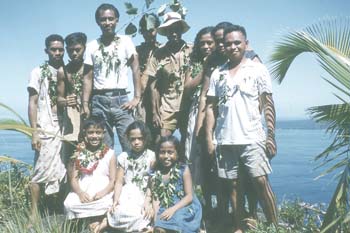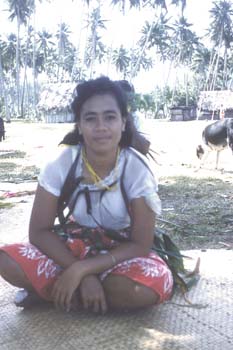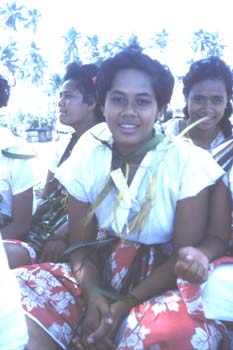The photo essay below is the fourth installment of a personal account of my two years in Fiji and Rotuma from October 1959 through August 1961. The main purpose of this project is to provide photographic images that might be of interest to contemporary Rotumans.
I have forgotten the names of some of the people who appear in the photos and would welcome your help in identifying them. Information identifying people should be sent to <ahoward@hawaii.edu> Please identify the photos by the numbers (#) in the captions.
Episode 4: Getting Acquainted
The month of January 1960 was a period of intensive orientation to Rotuman culture. In the process I got to know more and more people, and found myself feeling increasingly comfortable and at home. During the first half of the month it was still mane'a (Christmas holidays), so I went fara (to Motusa) with the youths from Itu'muta, and participated in the tautoga competitions between Lopo (where I lived) and Maftoa. There were several competitions over the mane'a period, and we alternated, one time in Lopo, the next in Maftoa. At the end of mane'a the folks from Maftoa treated the whole district to a big feast. Often times during this period I didn't get home until 2 or 3 o'clock in the morning and had to sleep in during the mornings.
Unfortunately our fun was sadly interrupted by the death of Sister Madeleine's 17-year-old brother, Tifere, from spinal meningitis on 4 January. Sister Madeleine invited me to the funeral, which took place at Sumi, with Father Maguire presiding. It was the first time I saw a Rotuman-style funeral and I was fascinated by the combination of Rotuman and Catholic customs.
|
|
The respect the people showed to the chiefs was very interesting to me, and I began to study Rotuman customs concerning their roles in ceremonies and in society in general. The contrast with Fiji was quite evident. In Fiji, high chiefs were treated almost like gods, whereas in Rotuma they were well respected, but much more human.
|
I got another chance to see a ceremony later in the month—this time a wedding. Filipo and Aliti, from Lopta, were married on 30 January 1960.

Filipo & Aliti
being wrapped in fine mats--the fau ceremony
One of the most pleasant things about Rotuma in those days was that so many people played guitars and ukuleles, and whenever people would get together they would make music and sing songs. Few people had radios, and there were no tape players (CDs hadn't been invented yet). Making music was a participant activity instead of a passive one of mostly listening to recordings. Aisea Nakaora and some of his friends came over to our place from time-to-time with their guitars and ukeleles; we would sit on mats outside under the stars and sing for hours.

Young woman in Motusa practicing playing a guitar
After my experience of a "picnic" to Hatana I should have known better, but I couldn't refuse when invited to go with a group of Itu'muta men to the island of Uea where they were going to cut copra. The men who owned land there stayed for several days working, but several of us took the opportunity to spend a day exploring the island and climbing to the top. Landing on Uea wasn't quite as treacherous as landing on Hatana, but it was no piece of cake either. The landing place was a large rock that one had to leap onto from the launch. You had to time it right, waiting for a wave to bring the launch up to the level of the rock; if you didn't time it right you could end up in a lot of trouble! Also, the climb up to the top of the island was somewhat treacherous. Several times I found myself on a narrow ledge on the edge of a cliff, grabbing hold of a branch to pull myself up. I came to admire the fearlessness of the young children who were with us and took courage from them. It was my first introduction to that part of Rotuman humor that laughs at near accidents; I couldn't believe people were laughing when someone lost their footing and almost fell off the cliff. But we all made it to the top and the view of Rotuma from there was magnificent.

The gang at the top of Uea (Master Ieli Irava at the
right)
All the while I kept meeting and getting to know people who were invariably kind and helpful in my research. I remain forever grateful to them. Here are some of the ones I met early on.
|
|
As I settled in, and began to feel really at home on the island, I noticed just how good looking Rotumans are, especially the young women (I was only 25 years old at the time so couldn't help noticing). Here are a couple of the young women who caught my attention.
|
|






